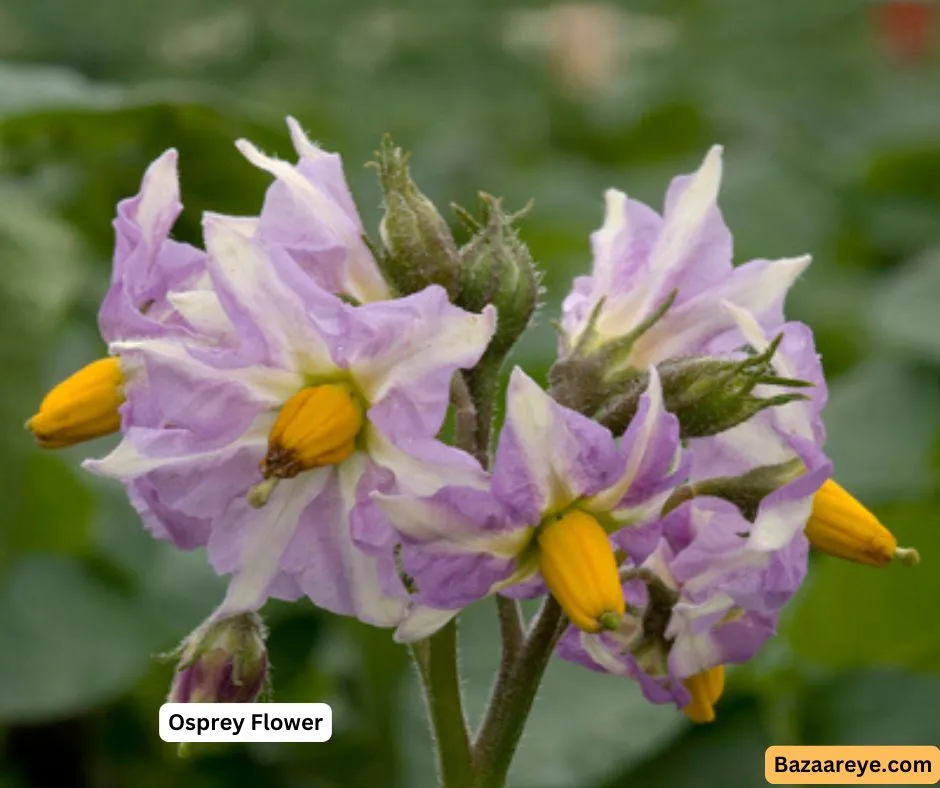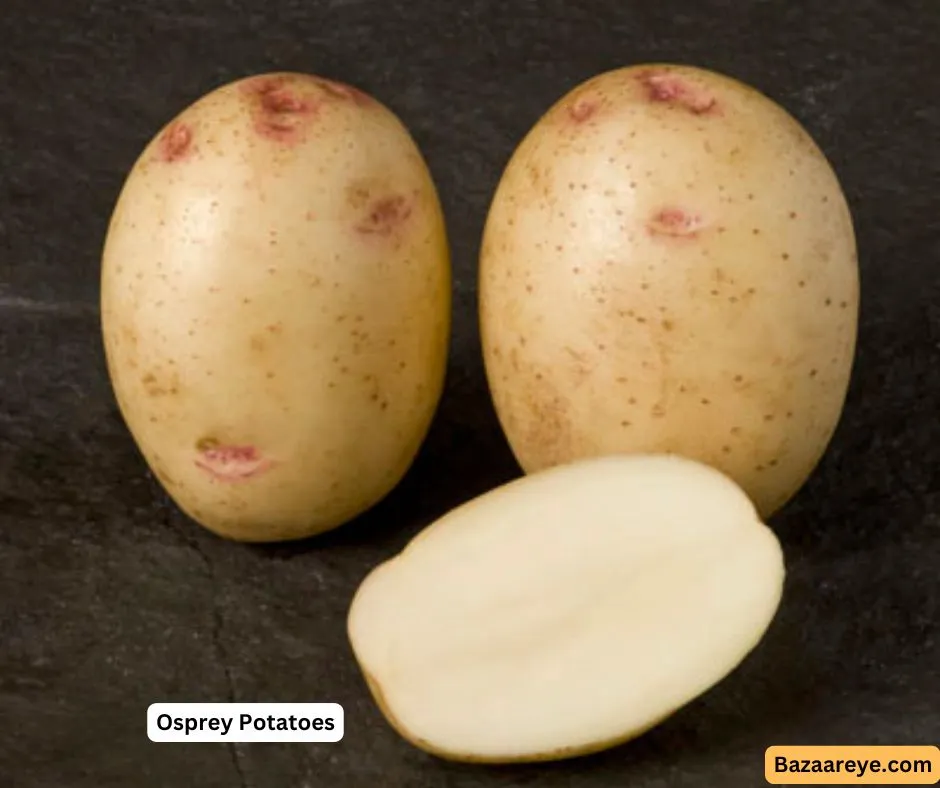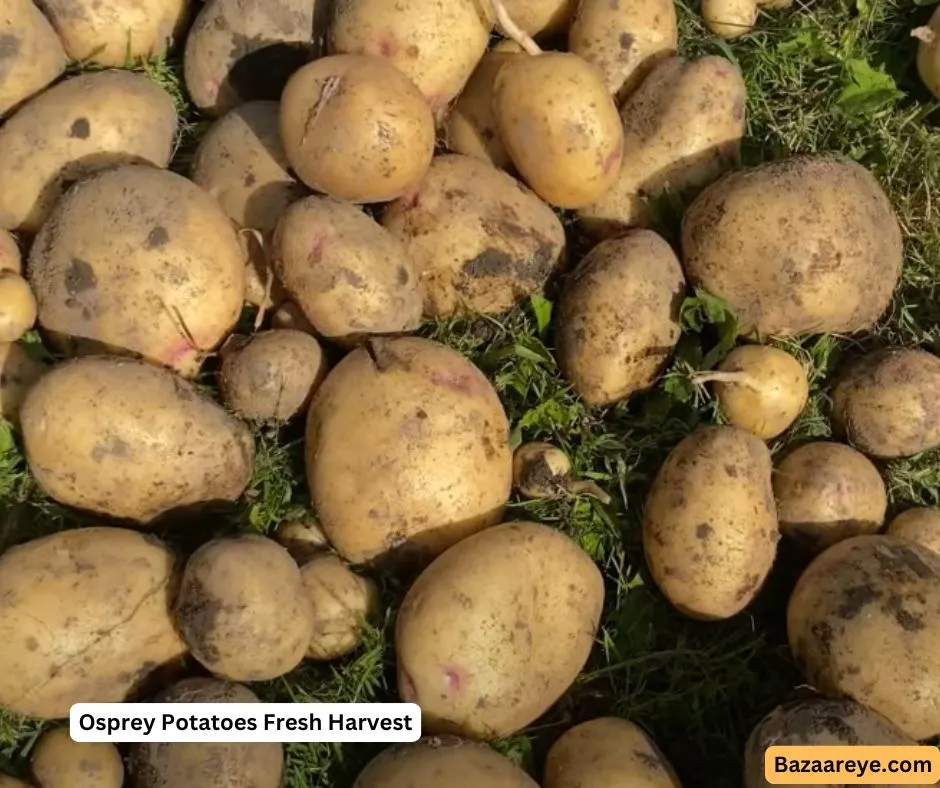Osprey potatoes are known for their early maturity and excellent all-purpose qualities, making them a popular choice for gardeners and commercial growers alike. With unique plant characteristics, favorable growth habits, and strong culinary applications, Osprey potatoes are worth considering for anyone looking to produce a reliable, tasty crop.
Plant Characteristics of Osprey Potatoes
The plant characteristics of Osprey potatoes make them easily identifiable and adaptable to various growing environments. Here’s a breakdown of the key features that make these potatoes a great early-season choice:
- Maturity: Osprey potatoes are an early-maturing variety, making them ideal for growers seeking a quick and dependable harvest. Their early maturity means they’re ready for harvesting sooner than many other potato varieties, allowing for successive planting and harvesting cycles.
- Growth Habit: Osprey potatoes exhibit a spreading to semi-erect growth habit. This growth pattern ensures a good foliage cover, which helps protect the tubers from direct sunlight and temperature fluctuations. The spreading nature of the plants also allows for better airflow around the foliage, reducing the chances of certain diseases.
- Flower Color and Frequency: Osprey plants produce frequent red-violet flowers, adding a touch of color to the garden during the flowering phase. The abundant flowering is not only a visual treat but also indicates a healthy and vigorous plant.
- Berries: these potatoes do not produce berries, which can be advantageous in terms of maintenance, as there’s no need to remove them for the sake of plant energy conservation.
- Light Sprout Color: The light sprouts of these potatoes are pink, a unique feature that aids in identification and adds a bit of color when the potatoes begin to sprout.

Why Choose Osprey Potatoes?
Osprey potatoes are a practical choice for home gardeners, small-scale growers, and commercial farmers due to their early maturity and reliable growth characteristics. They fit well into crop rotation plans, allowing for a quick harvest that frees up space for additional plantings. Their semi-erect growth habit and dense foliage help shade the soil, providing natural weed suppression and protecting the tubers from sunlight.
With their frequent flowering and lack of berry production, these potatoes are relatively low maintenance, and the pink sprout color is a bonus for visual identification.
Read More: Sarpo Mira Potatoes for Organic Farming
Growing Tips for Osprey Potatoes
To make the most of this early-maturing potato variety, follow these tips for optimal growth and yield:
- Soil Preparation: Osprey potatoes thrive in well-drained, loamy soil rich in organic matter. Ensure the soil pH is slightly acidic (between 5.0 and 6.5) to support healthy root development and reduce the risk of diseases like scabs.
- Planting Depth and Spacing: Plant seed potatoes around 4 inches deep, with 12-15 inches of space between plants and 24-36 inches between rows to accommodate their spreading habit.
- Watering: Keep the soil consistently moist but avoid waterlogging. An even moisture level throughout the growing season is essential for producing uniform tubers.
- Earthing Up: Mound soil around the base of the plants as they grow to prevent tuber exposure to sunlight, which can cause greening and reduce quality.
- Fertilization: A balanced fertilizer high in potassium can help Osprey potatoes produce high-quality tubers, while phosphorus supports root development, especially in the early growth stages.
Harvesting Osprey Potatoes
As an early-maturing variety, Osprey potatoes can typically be harvested around 10-12 weeks after planting. Once the plants flower and the foliage begins to yellow, it’s usually a good indication that the potatoes are ready for harvest. Be gentle when digging to avoid damaging the smooth-skinned tubers, and allow them to cure in a dry, cool area for a few days before storage.
Culinary Uses of Osprey Potatoes
Osprey potatoes are highly versatile in the kitchen, with a texture that holds up well for various cooking methods. They are ideal for:
- Boiling and Steaming: Osprey potatoes maintain their shape well, making them perfect for boiling and steaming for salads, sides, or soups.
- Roasting and Baking: Their early maturity allows for tender, flavorful tubers that roast beautifully, with a creamy interior.
- Mashing: The texture of Osprey potatoes also makes them suitable for mashing, resulting in a fluffy, smooth consistency.
Discover the high yield Nicola potato breed
Tuber Characteristics of Osprey Potatoes
The tubers of Osprey potatoes have distinctive features that make them appealing for both commercial use and home cooking. Here’s an in-depth look at the tuber characteristics that set Osprey potatoes apart:
Tuber Skin Texture: The skin texture of Osprey potatoes is intermediate. This skin texture offers some resilience, protecting the tubers during harvest and storage, while still being easy to clean and prepare in the kitchen.
Tuber Skin Color: Osprey potatoes have a partly red skin color, creating an attractive appearance that stands out from more common white or yellow-skinned varieties. This partial red skin also makes these potatoes easy to identify at harvest time and appealing for market presentation.
Tuber Eye Color: The eyes of Osprey tubers are red, which adds another layer of visual appeal. Red eyes make these potatoes recognizable and distinctive, especially in produce displays.

Primary Tuber Flesh Color: The cream-colored flesh of Osprey potatoes is mild and smooth, with a pleasant texture. Cream flesh complements a wide range of culinary applications, making them versatile and appealing for both home cooks and chefs.
Tuber Shape: Osprey potatoes have an oval to round shape, a classic and practical shape that is easy to work with in the kitchen. Oval-round potatoes are ideal for uniform slicing, dicing, and serving, which makes them versatile for various cooking methods, from roasting to boiling.
Tuber Eye Depth: With medium eye depth, Osprey potatoes strike a balance between shallow and deep eyes. This feature means they are relatively easy to peel, with less wasted flesh, but still have enough depth to be visually identifiable, especially due to their red coloration.
Tubering Characteristics of Osprey Potatoes
Osprey potatoes exhibit strong tubering characteristics that make them a reliable and resilient choice for both commercial growers and home gardeners. Here’s a detailed breakdown of their tubering traits:
Resistance to Internal Bruising: Osprey potatoes boast high resistance to internal bruising, a valuable characteristic that contributes to their quality during harvest and storage. This high resistance means that the tubers are less likely to develop unsightly bruising beneath the skin, preserving their quality over longer periods and making them ideal for handling and extended storage.
Tuber Shape Uniformity: Osprey potatoes have a uniform tuber shape, which is especially advantageous for packaging, cooking, and presentation. Uniformity in shape makes them easy to prepare and cook consistently, providing an appealing look for retail markets and a practical option for consumers.
Resistance to External Damage: The tuber of osprey are moderate to resistant to external damage, which means they are generally hardy and can withstand typical handling and transportation processes. This resistance reduces the risk of surface blemishes and other minor damage, ensuring a higher-quality appearance at the market and in the kitchen.
Discover the late season crop for your farm: Mayan Gold Potatoes
Utilization Characteristics of Osprey Potatoes
Osprey potatoes have a low to medium dry matter content, which influences their texture and culinary versatility. Here’s a closer look at how this dry matter level affects their use in the kitchen:
Not Best for Frying: Because of their lower dry matter, Osprey potatoes are not the best choice for frying or making crispy potato dishes like French fries or chips. Potatoes with higher dry matter content typically produce crispier results, whereas Osprey’s waxy nature makes them better suited to softer preparations.
Texture and Cooking Qualities: Due to their low to medium dry matter content, these potatoes have a moist and somewhat waxy texture when cooked. This characteristic makes them ideal for cooking methods where they need to retain their shape, such as boiling, steaming, and roasting. They’re also great for making salads or dishes where potatoes hold up well without becoming overly crumbly or dry.
Ideal for Multi-Purpose Use: The moderate dry matter in Osprey potatoes makes them versatile in the kitchen and suited to a wide range of recipes. They are particularly good for soups, stews, and casseroles, where a smooth, moist texture is desired. Their waxy quality allows them to absorb flavors effectively while maintaining their structure, adding a rich texture to dishes.
Resistance to Fungal Diseases in Osprey Potatoes
Osprey potatoes demonstrate notable resistance to several common fungal diseases, making them a reliable choice for growers aiming to minimize losses due to fungal infections. Here’s a breakdown of their resilience:
Resistance to Gangrene (Phoma Foveata): Osprey potatoes show medium to high resistance to gangrene, a disease that can develop during storage. This level of resistance helps reduce losses during long-term storage and ensures that the tubers maintain quality and shelf life.
Resistance to Late Blight:
Tubers: Osprey potatoes show medium to high resistance to late blight on tubers, an essential trait for maintaining quality during storage and reducing tuber loss due to rot. This resistance is beneficial for long-term storage, ensuring the tubers remain intact.

Foliage: They also have medium to high resistance to late blight on foliage, which helps reduce the risk of rapid disease spread through the leaves. This dual resistance helps keep the plant healthy and productive throughout the growing season, even in areas prone to late blight outbreaks.
Resistance to Powdery Scab (Spongospora Subterranea): These potatoes offer medium to high resistance to powdery scab, a disease that can affect the skin of the tubers. This resistance makes them less susceptible to blemishes and helps maintain tuber quality and market value, especially in wetter conditions where powdery scab is more prevalent.
Field Immunity to Wart (Synchytrium Endobioticum): Osprey potatoes have field immunity to wart, a critical advantage in disease management. Wart can be highly destructive, causing growth deformities in tubers, but Osprey’s field immunity means it can be grown safely in areas where wart is a concern.
Discover the versatile breed of Lady Rosetta Potatoes
Resistance to Bacterial Diseases in Osprey Potatoes
Osprey potatoes have solid resistance to bacterial diseases, contributing to their reliability as a high-quality crop. Here’s a look at how they perform against common bacterial threats:
Resistance to Blackleg (Erwinia spp.): One of the standout characteristics of Osprey potatoes is their very high resistance to blackleg. Blackleg, which causes wilting and stem rot, can devastate potato crops, particularly in wet conditions. The high resistance to blackleg means it’s more resilient during wet seasons, reducing the risk of crop loss and preserving plant health and yield.
Resistance to Common Scab (Streptomyces scabies): Osprey potatoes demonstrate medium to high resistance to common scab, a disease that can cause rough, scabby lesions on the tuber surface. This resistance is beneficial for maintaining tuber appearance and quality, especially in soils where scab is more prevalent. By minimizing scab formation, these potatoes retain smoother, more marketable tubers that are ideal for fresh produce markets.
Resistance to Virus Diseases in Osprey Potatoes
Osprey potatoes exhibit mixed resistance to common potato viruses, offering moderate resilience against some viral threats while being more vulnerable to others. Here’s a detailed overview:
Resistance to Potato Leaf Roll Virus (PLRV): In contrast, these potatoes have very low resistance to Potato Leaf Roll Virus. PLRV causes leaf rolling and stunted growth, potentially leading to significant yield losses, especially in areas where this virus is prevalent. Due to its low resistance, Osprey potatoes may require careful management to reduce the risk of PLRV transmission, especially in regions where the virus is common.
Resistance to Potato Virus Y (PVY): Osprey potatoes have medium to high resistance to Potato Virus Y, a virus that can lead to yield loss and reduce the overall health of potato plants. This level of resistance helps protect the crop from one of the more common viral diseases, enabling Osprey plants to remain healthier and more productive under typical PVY exposure.
Resistance to Pests in Osprey Potatoes
Osprey potatoes have limited resistance to nematode pests, particularly certain races of potato cyst nematodes (PCN), which can affect potato yield and tuber quality in infested soils. Here’s a breakdown of their pest resistance:
Resistance to Globodera Pallida (Races 1, 2, and 3): Against Globodera pallida, another type of PCN, Osprey potatoes show low resistance across races 1, 2, and 3. This low resistance level means they are susceptible to pallida infestations, potentially impacting yield and tuber health.
Resistance to Globodera Rostochiensis Race 1: Osprey potatoes have a low to moderate resistance to Globodera Rostochiensis Race 1, which offers a slight advantage in soils with mild infestations. However, moderate resistance may not fully protect crops in highly infested fields, so additional pest management practices may be necessary.
Read more about this high-yield quality breed
Conclusion
Osprey potatoes are a versatile and reliable choice for growers, with strengths in several key areas. They offer medium to high resistance to various fungal diseases, making them resilient against threats like late blight. However, they show limited resistance to certain bacterial diseases, specifically very high resistance to blackleg and medium to high resistance to common scab.
In terms of viral diseases, they are moderately resistant to Potato Virus Y and more vulnerable to Potato Leaf Roll Virus. Regarding pests, Osprey potatoes have low to moderate resistance against potato cyst nematodes, necessitating careful management in infested areas. Their strong disease resistance makes them a good option for various growing conditions, but growers should remain vigilant about specific viral and pest threats.
2 thoughts on “Understanding Osprey Potatoes: Key Traits for Successful Cultivation”